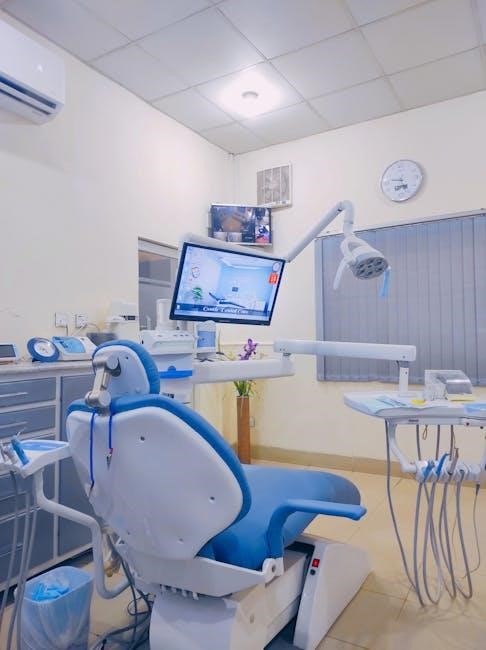medical office policy and procedure manual pdf
The Medical Office Policy and Procedure Manual serves as a comprehensive guide for managing daily operations, ensuring compliance, and maintaining high standards of patient care. Designed for all medical practices, it outlines essential policies, procedures, and forms to streamline workflows and reduce risks. By standardizing processes, it helps practices operate efficiently while adhering to regulatory requirements.
Overview of the Medical Office Policy and Procedure Manual
A Medical Office Policy and Procedure Manual is a detailed document outlining the rules, processes, and guidelines for operating a medical practice efficiently. It covers essential aspects like patient care, staff responsibilities, compliance, and risk management. Designed for practices of all sizes, the manual ensures consistency, reduces errors, and promotes a safe environment. Regular updates keep it aligned with industry standards and regulations, making it a vital resource for daily operations.
Importance of a Policy and Procedure Manual in Medical Practices
Importance of a Policy and Procedure Manual in Medical Practices
A Policy and Procedure Manual is crucial for medical practices as it ensures compliance with regulations, reduces legal risks, and improves patient care. It provides clear guidelines for staff, promoting consistency and efficiency in daily tasks. By standardizing operations, it helps practices maintain quality, safety, and accountability, ultimately enhancing their reputation and operational success.

Key Components of the Medical Office Policy and Procedure Manual
The manual includes essential policies, standardized procedures, compliance guidelines, risk management strategies, and necessary forms/templates to ensure efficient and lawful medical office operations.
Essential Policies for Medical Office Operations
Essential policies ensure the smooth functioning of medical offices, covering patient confidentiality, informed consent, and financial management. They provide clear guidelines for staff, reducing legal risks and ensuring compliance with regulations like HIPAA. These policies are tailored to address specific office needs, fostering a structured and efficient work environment while maintaining patient trust and safety.
Standard Procedures for Daily Medical Office Tasks
Standard procedures streamline daily tasks, ensuring efficiency and consistency in medical office operations. They cover patient intake, appointment scheduling, record-keeping, and billing processes. These procedures provide clear step-by-step guidance, reducing errors and improving productivity. By following established protocols, staff can maintain organized workflows, ensuring accurate documentation and compliance with office policies. This consistency enhances patient care and operational effectiveness.
Forms and Templates for Efficient Office Management
Forms and templates are essential tools for streamlining medical office operations. They include patient intake forms, consent documents, and billing templates, ensuring consistency and accuracy. Customizable templates save time and reduce errors, while standardized forms facilitate compliance with regulatory requirements. Regular updates keep them relevant, ensuring efficient office management and improved patient care delivery.

Compliance with Regulations and Standards
Compliance ensures adherence to HIPAA, OSHA, and state-specific regulations, safeguarding patient data, ensuring workplace safety, and meeting legal requirements for medical practices.
Understanding HIPAA Compliance in Medical Offices
HIPAA compliance is crucial for protecting patient privacy and ensuring secure handling of health information. The manual provides clear guidelines on implementing HIPAA standards, including patient rights, data security, and breach notifications. By following these policies, medical offices can avoid legal penalties and build patient trust while maintaining confidentiality. Regular staff training and audits are essential to uphold compliance effectively.
OSHA Guidelines for Medical Office Safety
OSHA guidelines ensure a safe environment for staff and patients by addressing hazards like bloodborne pathogens and chemical exposure. The manual outlines proper use of PPE, waste disposal, and emergency preparedness. Regular training, safety inspections, and incident reporting are emphasized to maintain compliance and prevent workplace injuries, ensuring a secure and healthy setting for all. Updates keep practices aligned with current regulations.
State-Specific Regulations and Requirements
Medical offices must adhere to state-specific laws and regulations, which vary by jurisdiction. The manual includes guidelines for compliance with local requirements, such as patient consent laws, privacy standards, and mandatory reporting. It also addresses state-specific forms and documentation needs, ensuring practices remain compliant while adapting to regional rules. Regular updates reflect changes in state legislation to maintain operational integrity.

Risk Management in Medical Office Policies
Risk management is crucial for minimizing errors and ensuring patient safety in medical offices. It involves clear policies, effective procedures, and regular updates to maintain compliance and reduce liability.
Identifying Potential Risks in Medical Practice
Identifying potential risks in medical practice involves assessing operational, clinical, and regulatory challenges. Policies and procedures must address patient safety, data security, and compliance with standards like HIPAA. Regular audits and staff training help mitigate risks, ensuring a safe environment for both patients and staff. Proactive risk management enhances patient care and reduces legal liabilities.
Developing Strategies to Mitigate Risks
Developing strategies to mitigate risks involves creating clear policies, conducting regular staff training, and implementing compliance protocols. Proactive measures include patient safety protocols, data security safeguards, and emergency response plans. Regular audits and feedback loops ensure adherence to standards, reducing legal and operational risks while fostering a culture of safety and accountability in the medical office environment.
Implementing Risk Management Protocols
Implementing risk management protocols involves systematic approaches to identify, assess, and address potential risks. This includes incident reporting systems, compliance audits, and staff training on safety measures. Regular monitoring ensures adherence to established guidelines, while continuous improvement processes refine protocols over time. Effective implementation fosters a safe environment, protects patient well-being, and minimizes legal and operational vulnerabilities in the medical office setting.

Importance of a Comprehensive Policy and Procedure Manual
A comprehensive policy and procedure manual is essential for ensuring compliance, efficiency, and risk mitigation, while standardizing operations and supporting high-quality patient care in medical offices.
Benefits of a Well-Structured Policy Manual
A well-structured policy manual ensures compliance with regulations, enhances efficiency, and mitigates risks. It standardizes operations, supports consistent patient care, and clarifies staff roles and responsibilities. By providing clear guidelines, it reduces errors, improves decision-making, and ensures accountability. A comprehensive manual also fosters a culture of transparency and professionalism, ultimately benefiting both the practice and its patients.
Enhancing Patient Care Through Clear Procedures
Clear procedures in a medical office manual ensure consistent, high-quality patient care by standardizing workflows and minimizing errors. They provide detailed guidance on informed consent, treatment protocols, and emergency responses, ensuring patients receive appropriate care. Standardized protocols enhance patient safety, improve outcomes, and facilitate better communication between staff and patients, fostering trust and satisfaction. This clarity also ensures compliance with ethical and legal standards, benefiting both patients and providers.
Ensuring Compliance and Reducing Liabilities
A well-structured policy manual ensures compliance with regulatory standards, such as HIPAA and OSHA, by outlining clear guidelines for staff. It minimizes legal risks by providing consistent, defensible procedures for handling patient data, informed consent, and emergency situations. By adhering to established protocols, practices reduce liabilities, protect patient confidentiality, and maintain operational integrity, safeguarding both patients and the organization from potential legal issues.

How to Develop a Medical Office Policy and Procedure Manual
Developing a medical office manual involves defining its scope, identifying key policies, involving staff, ensuring compliance, and organizing content for clarity and accessibility.
Step-by-Step Guide to Creating the Manual
Start by defining objectives and scope, then involve the team in drafting policies. Outline sections for operations, patient care, and compliance. Draft clear, concise policies and procedures, ensuring they align with regulations. Review and approve content, then format for accessibility. Finally, implement the manual, ensuring staff training and regular updates to maintain relevance and compliance.
Defining the Scope and Purpose of the Manual
The manual’s purpose is to provide clear guidelines for medical office operations, ensuring consistency and compliance. Its scope includes policies for patient care, administrative tasks, and regulatory adherence. By outlining roles, responsibilities, and procedures, it helps staff make informed decisions, maintain efficiency, and deliver high-quality care while minimizing risks and ensuring adherence to legal and ethical standards.
Involving the Medical Office Team in the Development Process
Involving the medical office team ensures diverse perspectives and practical insights, fostering a collaborative environment. Staff contributions help tailor policies to real-world scenarios, enhancing relevance and adherence. This shared responsibility promotes accountability and ensures everyone understands their roles in maintaining high standards of patient care and operational efficiency.

Implementing and Maintaining the Policy and Procedure Manual
Effective implementation involves training, clear communication, and regular updates to ensure compliance and adapt to changing regulations. Maintaining the manual requires ongoing reviews and staff engagement.
Effective Implementation Strategies
Successful implementation involves staff training, clear communication of expectations, and regular updates. Assigning a team leader ensures accountability and consistency. Providing checklists and timelines helps track progress. Conducting audits and gathering feedback ensures the manual remains relevant and effective. Regular reviews and updates keep the document aligned with current regulations and office needs, fostering a culture of compliance and efficiency.
Regular Updates and Revisions
Regular updates and revisions are crucial to ensure the manual remains current with evolving regulations and office practices. Automated tools streamline the update process, allowing for quick access to the latest guidelines. Annual reviews, staff feedback, and version control help maintain accuracy. Incorporating updates from organizations like the AAFP ensures compliance and relevance, keeping the manual a vital resource for daily operations and decision-making.
Monitoring Compliance and Adherence
Monitoring compliance and adherence ensures that policies and procedures are consistently followed. Regular audits, checklists, and performance reviews help verify staff adherence. Automated tools in digital manuals can track compliance, while staff training reinforces understanding. Leadership oversight and feedback loops further ensure alignment with regulations, maintaining a culture of accountability and continuous improvement in office operations.
Training and Education for Staff
Training and education are essential for ensuring staff understand and adhere to policies and procedures. Regular workshops, digital resources, and updates keep teams informed, fostering a skilled and informed workforce.
Importance of Staff Training on Policies and Procedures
Staff training on policies and procedures is crucial for ensuring compliance, improving patient care, and reducing risks. Regular training sessions equip staff with the knowledge to follow guidelines accurately, promoting consistency and efficiency in daily operations. By staying informed, teams can adapt to updates and maintain high standards, fostering a safe and effective medical practice environment.
Conducting Regular Training Sessions
Regular training sessions are vital for ensuring staff understand and adhere to policies and procedures. These sessions should be interactive, covering updates on compliance, patient care, and office workflows. Involving all team members ensures consistency and preparedness. Automated tools and digital manuals can enhance accessibility and engagement, making training more efficient and effective for continuous improvement in medical office operations.
Ensuring Staff Understanding and Compliance
To ensure staff understanding and compliance, regular audits and feedback sessions should be conducted. This helps identify gaps in knowledge and adherence to policies. Providing accessible resources, such as digital manuals, ensures staff can review procedures anytime. Continuous training and clear communication are key to maintaining compliance and fostering a culture of accountability within the medical office.

Customizing the Manual for Specific Medical Practices
The manual can be tailored to meet the unique needs of different medical practices, ensuring policies and procedures align with specific specialties, office workflows, and patient care requirements.
Tailoring Policies to Fit Office Needs
Customizing policies ensures they align with the specific requirements of each medical office, addressing unique operational needs while maintaining compliance with regulations. Offices can adapt templates to reflect their workflows, patient demographics, and legal obligations. Involving staff in policy development fosters ownership and ensures practical, effective guidelines. Regular reviews help keep policies relevant and up-to-date.
Adapting Procedures for Specialty Practices
Specialty practices require tailored procedures that cater to their unique needs, ensuring efficient and compliant operations; Adapting processes involves modifying workflows, documentation, and patient care protocols to align with specific medical disciplines. By customizing standard procedures, practices can enhance patient outcomes, streamline tasks, and meet industry-specific regulations, ultimately improving overall efficiency and effectiveness.
Incorporating Office-Specific Forms and Templates
Incorporating office-specific forms and templates enhances operational efficiency and ensures consistency in documentation. These tools, such as patient charts, logs, and administrative forms, are tailored to meet the unique needs of the practice. Standardized templates for informed consent, treatment plans, and office policies reduce errors and save time. Including these resources in the manual ensures staff have easy access to essential materials, improving compliance and patient care.

Automation and Digitalization of the Manual
Digitalizing the manual in formats like PDF ensures easy access and sharing. Automated updates and notifications keep the manual current, improving efficiency and compliance in medical offices.
Benefits of a Digital Policy and Procedure Manual
A digital policy and procedure manual offers enhanced accessibility, cost savings, and efficiency. It eliminates the need for physical storage and ensures all staff can access updated information instantly. The digital format allows for real-time updates, reducing errors and ensuring compliance. Search functionality enables quick access to specific policies, improving productivity. Scalable and eco-friendly, it supports modern medical office needs while maintaining organization and clarity.
Using PDF Format for Easy Access and Sharing
The PDF format ensures easy access and sharing of the medical office policy and procedure manual. It maintains consistent formatting across devices, making it ideal for quick reference. PDFs can be easily shared via email or cloud storage, ensuring all staff have the latest updates. The ability to search within documents saves time, while password protection enhances security, maintaining confidentiality of sensitive information.
Integrating Automated Updates and Notifications
Automated updates and notifications ensure the medical office policy manual remains current and compliant. Digital platforms can alert staff to regulatory changes or procedural updates instantly, reducing manual oversight. This feature streamlines compliance, enhances efficiency, and ensures all team members are informed promptly, minimizing administrative burdens while maintaining accurate and up-to-date office policies and procedures.

Best Practices for Creating an Effective Manual
Use clear, concise language and an organized structure for easy navigation. Include real-world examples to enhance understanding and ensure the manual is accessible in digital formats like PDF.
Clear and Concise Language
Using clear and concise language ensures that policies and procedures are easily understood by all staff. Avoid jargon and complex terminology to make the manual user-friendly. Simple, straightforward language reduces confusion and enhances compliance. Ensure that each policy is explained in a way that is accessible to everyone, regardless of their role or expertise. This clarity fosters a culture of adherence and accountability within the medical office.
Clear language also helps mitigate risks by providing unambiguous guidelines for handling emergencies, patient confidentiality, and informed consent processes. By eliminating ambiguity, the manual becomes a reliable resource for daily operations and decision-making. This approach ensures that staff can quickly access and apply the necessary information, improving efficiency and patient care outcomes.
Organized Structure for Easy Navigation
A well-organized policy and procedure manual ensures easy navigation, allowing staff to quickly locate essential information. Use clear headings, sections, and subheadings to categorize policies and procedures logically. Include an index or table of contents for rapid access. Regularly update the structure to reflect changes in regulations or office practices, ensuring the manual remains user-friendly and relevant. This organized approach enhances efficiency and compliance.
Including Real-World Scenarios and Examples
Incorporating real-world scenarios and examples enhances the practical application of policies and procedures. For instance, detailing how to handle informed consent discussions or manage medical emergencies provides staff with actionable guidance. These examples help bridge theoretical policies with everyday challenges, ensuring clearer understanding and better decision-making in real-life situations. This approach makes the manual more relatable and effective for the entire medical team.
A well-structured Medical Office Policy and Procedure Manual is essential for ensuring compliance, reducing risks, and improving patient care. Regular updates and staff training are crucial for maintaining its effectiveness and relevance in a evolving healthcare landscape.
Summarizing the Key Points of the Manual
The Medical Office Policy and Procedure Manual provides a structured framework for managing operations, ensuring compliance, and enhancing patient care. It covers essential policies, procedures, and forms, addressing informed consent, risk management, and staff training. Regular updates and digital formats, like PDF, ensure accessibility and adherence to evolving regulations. This manual is a vital resource for maintaining efficiency, safety, and legal compliance in medical practices.
Future Directions for Policy and Procedure Development
Future policy development will focus on integrating advanced technologies like AI for real-time updates and specialty-specific guidelines. Emphasis will be placed on automation, staff training platforms, and patient engagement tools. Manuals will incorporate feedback mechanisms and sustainability practices, ensuring adaptability to evolving healthcare needs while maintaining compliance and enhancing operational efficiency.
Continuous Improvement in Medical Office Operations
Continuous improvement ensures medical offices stay efficient and compliant. Regular updates to policies and procedures, staff training, and patient feedback integration drive progress; Automation and advanced technologies enhance accuracy and reduce errors. By fostering a culture of improvement, offices can adapt to changing regulations and patient needs, ensuring high-quality care and operational excellence. This approach supports long-term success and patient satisfaction.
